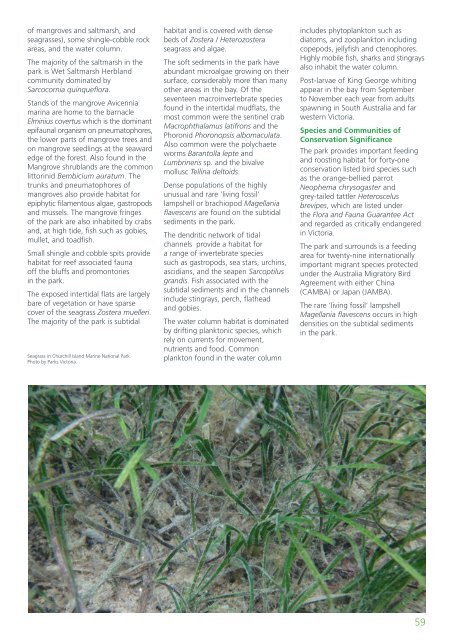Marine Natural Values Study Summary - Parks Victoria
Marine Natural Values Study Summary - Parks Victoria
Marine Natural Values Study Summary - Parks Victoria
Create successful ePaper yourself
Turn your PDF publications into a flip-book with our unique Google optimized e-Paper software.
of mangroves and saltmarsh, andseagrasses), some shingle-cobble rockareas, and the water column.The majority of the saltmarsh in thepark is Wet Saltmarsh Herblandcommunity dominated bySarcocornia quinqueflora.Stands of the mangrove Avicenniamarina are home to the barnacleElminius covertus which is the dominantepifaunal organism on pneumatophores,the lower parts of mangrove trees andon mangrove seedlings at the seawardedge of the forest. Also found in theMangrove shrublands are the commonlittorinid Bembicium auratum. Thetrunks and pneumatophores ofmangroves also provide habitat forepiphytic filamentous algae, gastropodsand mussels. The mangrove fringesof the park are also inhabited by crabsand, at high tide, fish such as gobies,mullet, and toadfish.Small shingle and cobble spits providehabitat for reef associated faunaoff the bluffs and promontoriesin the park.The exposed intertidal flats are largelybare of vegetation or have sparsecover of the seagrass Zostera muelleri.The majority of the park is subtidalSeagrass in Churchill Island <strong>Marine</strong> National Park.Photo by <strong>Parks</strong> <strong>Victoria</strong>.habitat and is covered with densebeds of Zostera / Heterozosteraseagrass and algae.The soft sediments in the park haveabundant microalgae growing on theirsurface, considerably more than manyother areas in the bay. Of theseventeen macroinvertebrate speciesfound in the intertidal mudflats, themost common were the sentinel crabMacrophthalamus latifrons and thePhoronid Phoronopsis albomaculata.Also common were the polychaeteworms Barantolla lepte andLumbrineris sp. and the bivalvemollusc Tellina deltoids.Dense populations of the highlyunusual and rare ‘living fossil’lampshell or brachiopod Magellaniaflavescens are found on the subtidalsediments in the park.The dendritic network of tidalchannels provide a habitat fora range of invertebrate speciessuch as gastropods, sea stars, urchins,ascidians, and the seapen Sarcoptilusgrandis. Fish associated with thesubtidal sediments and in the channelsinclude stingrays, perch, flatheadand gobies.The water column habitat is dominatedby drifting planktonic species, whichrely on currents for movement,nutrients and food. Commonplankton found in the water columnincludes phytoplankton such asdiatoms, and zooplankton includingcopepods, jellyfish and ctenophores.Highly mobile fish, sharks and stingraysalso inhabit the water column.Post-larvae of King George whitingappear in the bay from Septemberto November each year from adultsspawning in South Australia and farwestern <strong>Victoria</strong>.Species and Communities ofConservation SignificanceThe park provides important feedingand roosting habitat for forty-oneconservation listed bird species suchas the orange-bellied parrotNeophema chrysogaster andgrey-tailed tattler Heteroscelusbrevipes, which are listed underthe Flora and Fauna Guarantee Actand regarded as critically endangeredin <strong>Victoria</strong>.The park and surrounds is a feedingarea for twenty-nine internationallyimportant migrant species protectedunder the Australia Migratory BirdAgreement with either China(CAMBA) or Japan (JAMBA).The rare ‘living fossil’ lampshellMagellania flavescens occurs in highdensities on the subtidal sedimentsin the park.59
















